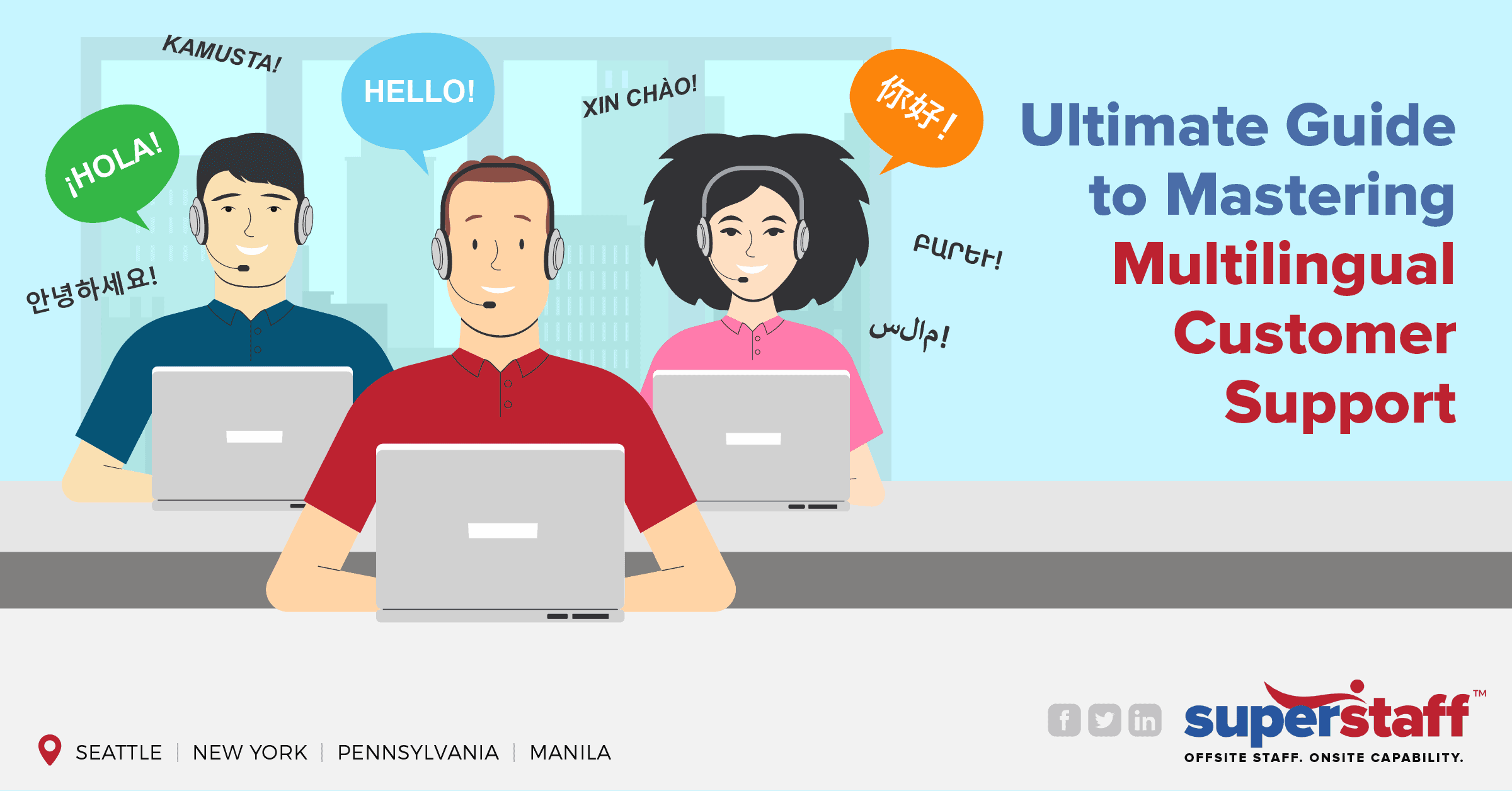
Picture this:
Your business is expanding. Your sales have grown more in the last month than in the previous three quarters of the year. While analyzing your sales data, you stumble upon a gold mine: you discover a growing number of customers from French-speaking areas. Last year, about 15% of your customers were from France, and 10% were from Quebec, Canada. Looking at the data, that chunk of consumers has increased to about 35% for both areas and is steadily increasing. Maybe it’s time to cater to this audience?
You consider the expenses that come along with the bold move you’re thinking of: translation of your website to other languages, hiring French representatives to add to your growing customer service team, and possibly setting up offices in Paris and Ontario. Everything sounds expensive; you take a step back.
And yes, a lot of resources are needed to make those things possible. But it would be a wise business decision to set up an office in Paris, considering the country’s affinity for the products and services you offer.
What are the challenges of in-house multilingual customer support?
Setting up in-house multilingual customer support presents significant challenges for any business. Take a look at these obstacles you might encounter.
- Is anyone on your current team bilingual?
Your products and services deserve more than just a quick “Google translate” approach. Implications often get lost in transition. Without knowing multiple languages, you cannot create a marketing strategy that will optimize your customer’s experience, relative to their culture.
- Different cultures have varying expectations
Imagine taking a subtle approach to customer service when engaging an American client. While Europeans prefer this approach, Americans might not feel valued when they experience European-style customer service. Cultural differences can either bring success or failure to any business. Trying to achieve in-house multilingual customer support is more than challenging because it isn’t just multilingual, it’s multicultural.
- Anticipate high cost when setting up in-house multi-language support
Consider all the expenses when opening and launching a multilingual call center. Unless you’re in a major metropolitan area with access to a large talent pool of your target languages, it may be more efficient to engage with an established multilingual call center that already has the expertise and the resources to make this happen for your business. Outsourcing to a multilingual call center lets you skip this learning curve, tap into a native workforce, and focus on your core services.
What’s the importance of speaking your customer’s language?
Statistics released by the International Customer Management Institute revealed that 70% of consumers are more likely to give positive feedback to businesses that offer language interpretation and multilingual customer support. The customers’ experiences with your support team will always determine their feedback.
Whether you own a small local business, an online store, or a multi-million dollar company striving for worldwide recognition, it doesn’t matter. It will always be the same for any size or type of business: if your customer service support doesn’t speak your customer’s language, this will magnify customer dissatisfaction.
Here are five reasons why speaking your customer’s language is imperative:
- It facilitates customer communication.
It is always better to communicate in your customer’s language to avoid miscommunication. Multicultural Expert and Author Michael Soon agree with this and added that if a customer is upset, forcing them to communicate in a second language may not be the best solution.
- It builds trust and loyalty.
If you are focused on long-term success, it’s vital that you let your customers know that you understand their needs. You can achieve a great customer experience by establishing trust and speaking your client’s language throughout the entire customer experience.
- It gives a competitive edge.
Think about this. Suppose you had a customer experience with two companies offering similar products and services with equal quality and value. The first company had an available customer representative who spoke your language, while the other expected you to speak a foreign language.
Who would be your primary choice in the future? You probably know the answer.
Statistics show that 66% of US consumers are willing to pay more for a product that offers exceptional customer service – and that includes having multilingual customer support.
- It improves your product
In 2017, $50-75 billion of Amazon seller’s revenue were estimated as cross-border transactions. As has been evident in global sales trends, businesses must be ready to respond to customer inquiries in more than one language.
The best way to minimize customer complaints is to have your FAQ page and voice support translated by experts. Having localized versions of your user manuals and knowledge bases will ensure that your international clients receive accurate instructions on how to assemble, use, and care for the products they purchase from you.
- It strengthens your value in the global market.
While English is an international business language, data from Can’t Read Won’t Buy published by Common Sense Advisory (CSA) found that 7 out of 10 consumers will purchase from a website written in their language.
Remember that just because your target market is a particular city or country doesn’t mean you should stick to only one language. For instance, while California is composed mainly of Americans, some of the most prevalent languages are Spanish, Chinese, and Filipino.
As part of the global market, customer service localization is an essential service, as opposed to an optional benefit.
Additionally, consider these three tips to achieve excellent multilingual support:
- Maximize the use of chatbots to make customer support more efficient
Using chatbots will lighten your team’s load by filtering out and handling the simple queries. With its 24/7 function, it can increase your customer’s satisfaction rate. Chatbots can also diagnose problems and appropriately transfer customer concerns to the right multilingual support agent.
- Explore opportunities to deploy self-service support
Self-service platforms ensure that your target clients have access to the information they need at any time. These platforms make sure that your clients aren’t left frustrated and abandoned just because you’ve closed up shop for the day.
Having professionally-translated knowledge-based articles and FAQs is also a significant factor in helping your multilingual support team respond to inquiries faster. You can now offer unified solutions to questions regarding your products and services around the clock.
- Strengthen your customer service by using translation tools
Invest in advanced translation options if your budget won’t allow you to offer multilingual customer support. Unbabel and other popular tools can translate chats, emails, and even FAQ pages between English and other languages.
Is translation the same as localization?
Although there are translation tools available for multi-language support, localization is still the best way to relate with your target audience.
As Localization Expert and Content Specialist Tobias Wiesner has explained, the focus of translation should always be correct grammar, precision, readability, and use of industry-specific terms. On the one hand, localized content needs to blend deeper within the tone, feel, and voice of the target culture and audience. Rules and regulations, idiomatic expressions as well as customs and values should also be honored with localization.
Take a look at how Uber nailed localization
In 2016, taxi-hailing giant Uber learned that about 20,000 riders in Toronto, Canada, had used their app in simplified or traditional Chinese language. To address this language barrier, the company launched UberCHINESE to cater to the growing need of the Mandarin-speaking community in Toronto.
As part of Uber’s globalization strategy, it also launched UberLITE which was offered in different languages spoken in India’s densely populated cities. Uber continues to expand its market by differentiating its offerings from local taxi-hailing services through multilingual support. To date, Uber is available in 32 different languages in more than 450 cities across 65 countries.
What does this mean for your business?
If large-scale businesses can successfully incorporate localization and multi-language customer support as part of their growth strategy, then so can you. The secret to effective customer care is a human touch. While machine translation may be useful for some business formats, language localization can help identify areas of improvement in your current globalization strategy.
Benefit from reputable experts by partnering with a multilingual call center
Before launching multi-language customer support, it is imperative to know how to find experts that will listen and understand your business.
Exactly how do you choose the right multilingual call center? The answer is relatively simple: find an outsourcing partner who understands your needs and has a policy that puts customers at the forefront of the business.
Five considerations can help determine if you are outsourcing to the right multilingual call center:
1. Determining languages for support
As a business owner, you will intimately know the demographics of the largest segment of your target audience. From that understanding, determine if your outsourcing partner has customer service representatives that cater to your selected countries and cultures.
2. Thinking in terms of self-service support
A translated FAQ page in different languages can resolve most issues without relying heavily on multilingual support representatives for resolutions. Choose a reputable multi-language support center that considers having this inexpensive option as a value-added service.
3. Considering support tickets
Chatbots, support tickets, multilingual customer support representatives: this should be the order of engagement for an effective outsourcing partner. Consider a multi-language call center that integrates chatbots that can answer simple queries without delegating to a live chat agent. A multilingual ticketing system will speed up the customer service process, making your business more efficient in terms of customer experience.
4. Employing localized customer support teams
How do you make your customers feel most comfortable? Communicate with them in their language. Although this may be a pricier option, outsourcing to a multilingual call center that hires native speakers will give your customers the comfort they deserve when voicing their concerns.
5. Using social media platforms for multilingual customer support
Another value-added service you should consider when hiring an outsourcing partner is to make sure their multilingual support agents are trained and able to handle both written and spoken inquiries in the designated languages. Their ability to employ native level customer support agents will allow your brand to be responsive on social media platforms which increases user engagement and brand loyalty.
The state of eCommerce businesses amidst the COVID-19 pandemic
While survey data shows that women are more concerned about the pandemic and its effects, men were more heavily impacted when it came to their shopping behaviors. The study shows that men were shopping online at a much higher rate than women, who often prefer in-store experiences. But overall, consumers are now opting for online shopping as part of their routine in the new normal. In response to this demand, businesses have considered embracing the ecommerce space as part of their overall marketing plan.
Among the notable winners in the ecommerce space during the pandemic were online grocery stores, meal deliveries, pet necessities, baby products, personal hygiene, and telehealth.
Incorporating multilingual customer support for your e-commerce website
In a CSA Research survey, out of 3,000 online shoppers across 60 countries, 60% disclosed that they rarely or never buy anything from English-only websites. Additionally, 76% prefer to purchase products with information translated into their native language.
Along with outsourcing to a multilingual customer support center, ecommerce businesses should also invest in carefully planned content and multilingual UX to increase website engagement and sales. Your ambition to grow in international markets will be successful if you pay close attention to multi-language markets and adjust your engagement strategy accordingly. Additionally, including a language selection box as part of your website user interface is the first step any ecommerce website should implement.
Five benefits of a multilingual ecommerce website
- Improve multilingual SEO
Translated versions of your eCommerce website will increase your overall SEO rank. Your increased online visibility in the search results will ultimately lead to a higher volume of website traffic that brings with it a higher conversion rate.
- Understand cultural differences
The more knowledge you have about a specific market, the better strategy you can design. Before designing a multilingual eCommerce website, you must learn about the local culture and understand the peculiarities so that you can properly position your products and services.
But the benefits don’t stop there. By understanding the market trends of foreign countries, you also gain significant market insights that are vital for developing your overall offerings. One example is how different cultures interpret colors to represent different values. This can be used as an inspiration to modify your branding strategy depending on specific target regions.
- Maximize cost-effective marketing solutions
It might surprise you to know that content marketing costs 62% less than traditional marketing. Given this benefit, considering a multilingual website is one of the best strategies you can implement for your marketing plan.
- Outdo competitors
Your target market is most likely flooded with all sorts of businesses trying to leave a lasting impression on your consumers. Adapting a multi-language website will leave your customers with a memorable and convenient experience that won’t be easily surpassed.
- Expand website reach
Neil Patel, a well-known online marketeer, once boosted online traffic by 47% in 3 weeks when he added 82 languages to his website. In another example, La Machine Cycle Club increased traffic by 50% just by adding 2 language options.
Want some additional fun facts? Chinese is the primary language for more than a billion internet users, and over 500 million users speak Spanish. These two languages however are only represented by less than 7% of all websites. Expanding your website reach by adding a multi-language option is crucial for targeting a broader audience.
Won’t English Do?
While English is the most widely spoken language, one in six people still speak Mandarin. With over 7,000 languages spoken in the world today, imagine how many customers you can reach by expanding your customer service through multi-language support.
With a multilingual call center as part of your customer engagement strategy, your potential customers can now have their concerns answered in the language they speak, 24-hour a day. To eliminate the challenges of setting up your own multi-language customer service team, you can opt to partner with a reputable call center.
Partner with SuperStaff and expand your global reach today.






